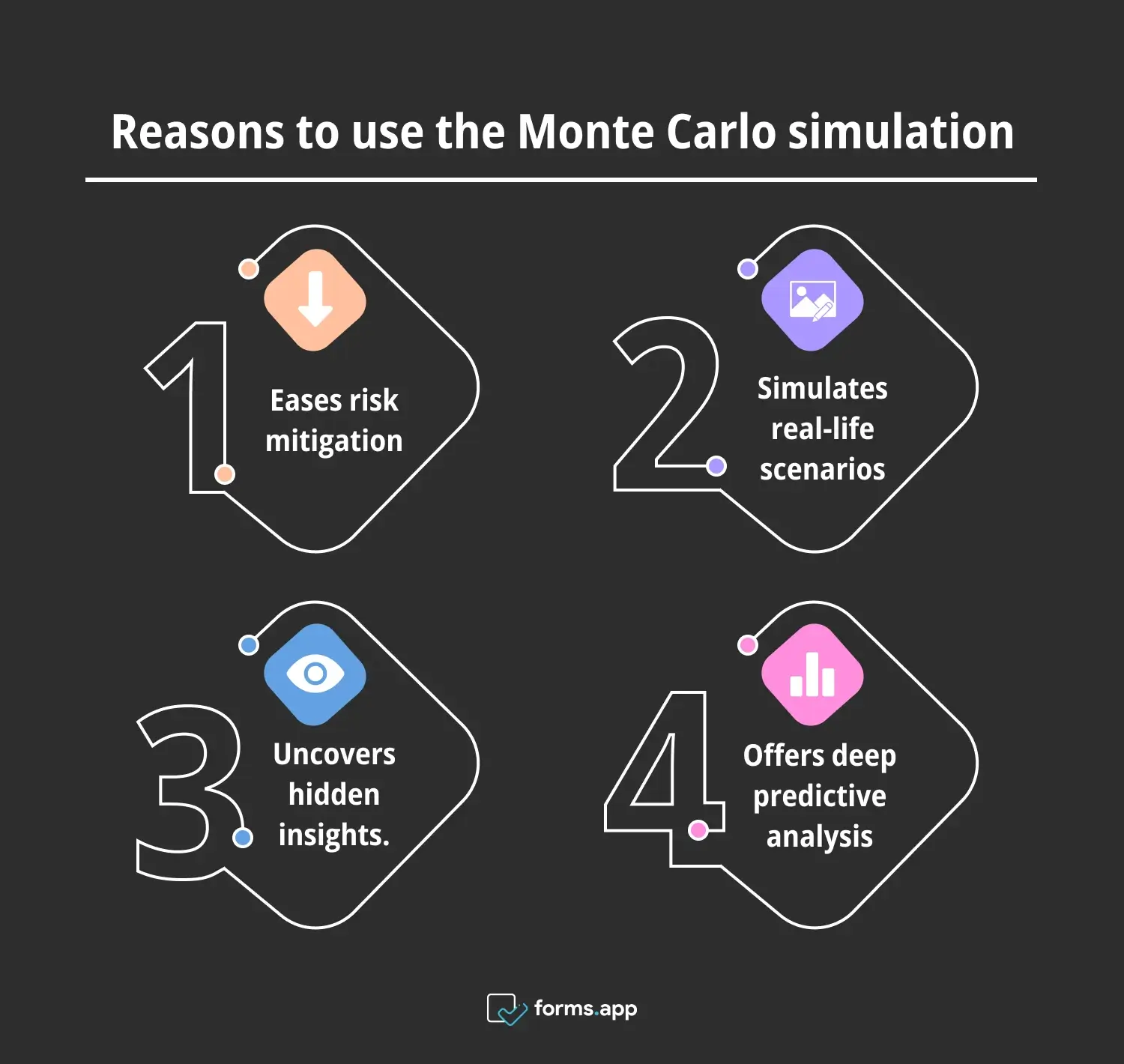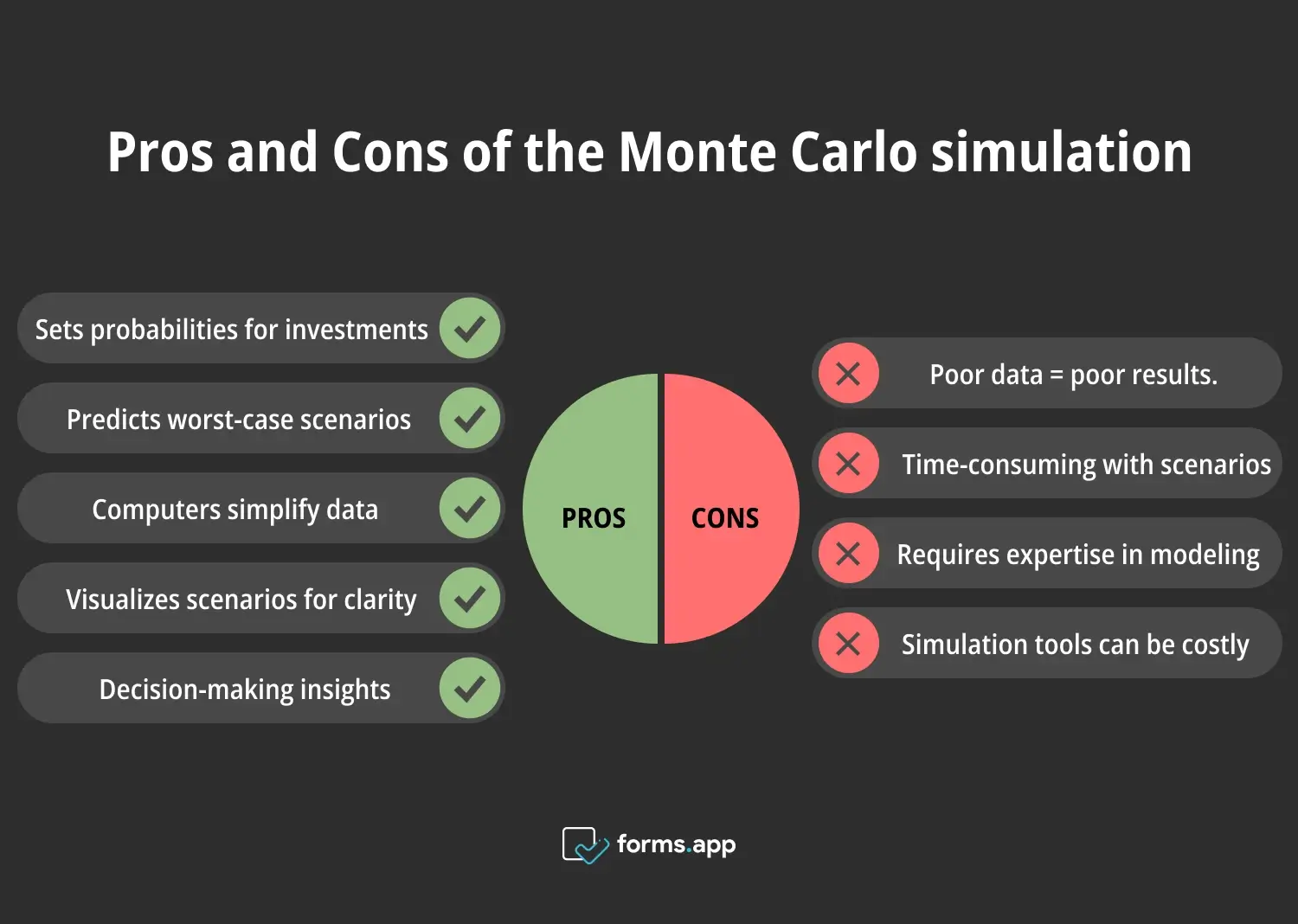
Have you ever wondered how to solve a problem amid uncertainty? Do you know how large companies anticipate risks and arrive at forecasts in such situations? Imagine if there was a method suitable for unknown results and complex data sets; that's Monte Carlo simulation.
In this comprehensive article, the Monte Carlo simulation will first be introduced with its definition, and then its background will be shared with you. It will then explain why it is important and show use cases with examples. Finally, the article will end by discussing how it works and its pros and cons.
What is the Monte Carlo simulation?

Monte Carlo simulation is a powerful analysis method that provides different results for events and processes that are difficult to predict.
It usually gets input from historical data. Monte Carlo simulations are a preferred technique to ward off uncertainty and risk, so they are used to combat problems in a wide range of fields. However, applications may differ depending on each field. For example, Monte Carlo simulations in finance may be slightly different from Monte Carlo simulations in project management.
Background of the Monte Carlo simulation
In its modern sense, Monte Carlo simulation is a method first developed by Stanislaw Ulam in the late 1940s. It provided what physicists needed to solve some problems: accounting for chance and randomness. It takes its name from the Monte Carlo Casino in Monaco. This name was not only related to the randomness of casino games but also got its name from Ulam's uncle's casino habit.
This technique, especially with the invention of the first computers, allowed complex mathematical problems to be solved by the random sampling method. Primarily used for nuclear physics problems, this method was quickly adopted by other fields thanks to its excellent results. It has now become one of the essential tools used by the business world and engineering when performing risk analysis.
Why is the Monte Carlo simulation important?
Monte Carlo simulation is considered one of the most successful and impressive ideas of the twentieth century. Thanks to its ability to solve many complex physics and financial problems, it has been a preferred mathematics technique in science and technology. Apart from that, the key reason for its significance is:

Advantages of using the Monte Carlo Simulation
🗝️It allows preparation for uncertain future events. Thus, risk mitigation is more easily achieved.
🗝️Don't see this as just a method used by companies or scientists to make future predictions. It is versatile; as long as you have data, you can simulate many scenarios of daily life problems.
🗝️It offers different perspectives on the event by presenting unthinkable or invisible scenarios to the human eye.
🗝️Unlike approaches focused on inputs and outputs, it carries out a more comprehensive predictive analysis.
Use cases of the model
Monte Carlo simulation is a method that you can easily use in many fields, from logistics to marketing, finance, engineering, and physics. The following are some Monte Carlo simulation real-life examples:
Example #1
A telephone line company can use simulation to anticipate potential hazards in a new market. It creates a simulation plane by taking into account many variables such as demand-supply, advertising cost, competing companies, subscription fees, and number of subscribers. As a result of simulations, it provides insights into whether this business is profitable or not.
Example #2
A logistics company that handles city-to-city transportation needs to optimize its operations. The company wants to use the simulation to ensure timely deliveries, minimize costs, and manage risks associated with variable factors such as traffic congestion, accident probabilities, demand fluctuations, toll costs, and fuel prices.
Even though there are so many variables and uncertainties, with simulations, the company can take the necessary precautions and improve its business.
How does the Monte Carlo simulation work?
In a Monte Carlo simulation, you start by defining a domain of possible inputs. Then, you randomly generate inputs with a probability distribution over the domain. For example, if probability distribution is normal, then you need mean and standard deviation.
You perform a deterministic simulation of the outputs and sum up the results. It is especially suitable for research with many variables and large samples. The computer system needs to receive very intense input to produce scenarios similar to the real world. It then tries to detect uncertainties using random number generators.
To give a simple example of this seemingly complex system, the chance of tossing a coin could be an example of this. No matter how many times you throw the coin in a row, you never know if you will get tails twice in a row. Theoretically, the probability of getting tails twice is twenty-five percent, but the more number of times simulations you make, the more confident you can be in the outcome. So, a hundred scenarios will always be more consistent than fifty.
Pros & Cons of the model
So far, examples of the use of the Monte Carlo technique have been given. Now, you will read the pros and cons that you need to consider when using this technique.

Advantages & disadvantages of the Monte Carlo simulation
Pros
- It is used to estimate the probability of situations such as gain and loss in investments and long-term plans. It is good for showing worst-case scenarios and predicting future outcomes.
- It helps you understand complex datasets thanks to its computer-aided calculations.
- It allows you to understand scenarios better by visualizing them with appropriate tools.
- It provides practical suggestions with a wide range of scenarios in decision-making and formation situations.
Cons
- The output quality is directly proportional to input quality. Incomplete or bad data results in poor calculation of probabilities.
- Finding the required large sample and examining hundreds of scenarios as a result of simulation can be time-consuming.
- Since computer and modeling knowledge is required, researchers who are experts in the field may be needed.
- The computer software and tools required for simulation and data collection for research can be costly.
Frequently asked questions about the Monte Carlo simulation
In this section, you can find what you want to learn about Monte Carlo simulation more quickly and directly.
La simulation de Monte Carlo est un algorithme de calcul utilisé pour modéliser la gamme de résultats possibles pour des événements imprévisibles. Elle est utilisée lorsqu'il y a de nombreuses variables aléatoires. Elle est très importante pour calculer les risques dans des domaines tels que l'ingénierie, le marketing, la gestion et la finance. Les scénarios créés par la simulation sont parfaits pour la gestion des risques et la prédiction dans ces domaines.
En gros, les cinq étapes de la simulation de Monte Carlo sont:
1. Commencez par répondre aux questions telles que: Quel est le problème? À quoi ressemblera le processus d'analyse? Quels sont les variables clés?
2. Créez un modèle mathématique adapté au processus d'analyse. Ayez quelque chose qui les inclut tous, en tenant compte des variables.
3. Vous devez créer de grands volumes d'échantillons pour créer de nombreux scénarios différents.
4. Exécutez la simulation en utilisant des échantillons aléatoires.
5. Finalisez votre recherche en évaluant les résultats des scénarios.
La méthode statistique de Monte Carlo peut être utilisée pour faire des prédictions dans un domaine tel que l'ingénierie. Par exemple, elle peut être appliquée pour estimer la durée de vie d'une structure. Selon les matériaux utilisés et les conditions de charge, un pont peut être simulé.
La méthode estime la durabilité et la vie d'un pont en se basant sur des centaines, voire des milliers de simulations. Ainsi, les problèmes de conception d'une structure peuvent être résolus avant qu'ils ne surviennent.
En bref, oui, vous pouvez le faire. Excel est parfait pour une analyse qui nécessite une modélisation mathématique, telle que la simulation de Monte Carlo. C'est un outil utile en soi et avec ses modules complémentaires (par exemple, @RISK, Crystal Ball) pour effectuer les fonctions et les calculs nécessaires.
Vous pouvez créer une simulation de Monte Carlo en quelques étapes dans un programme tel que Excel. Tout d'abord, déterminez votre modèle en fonction de votre problème de recherche et notez les équations et les variables qui correspondent à ce modèle.
Ensuite, des échantillons aléatoires seront créés en déterminant la distribution de probabilité. Répétez ces formules plusieurs fois, collectez les résultats dans un tableau et extrayez les statistiques. Maintenant, vous pouvez visualiser et commencer à interpréter les résultats avec les outils de graphique dans Excel.
Final words
Overall, Monte Carlo simulation is an important method for measuring risk and shedding light on future risks and uncertainties. Many different disciplines use this method to solve many different complex problems. However, as stated in the article, these processes can now be carried out quite easily with the help of computers and software. To help you get to know this useful method better, we started the article with its definition.
Then, its history and why it is important was mentioned. You were provided with Monte Carlo simulation examples to help you understand the topic better. Finally, we have come to the end of the article by listing how it works and its positive and negative aspects. Now, you can perform this useful analysis using what you have learned.
Atakan is a content writer at forms.app. He likes to research various fields like history, sociology, and psychology. He knows English and Korean. His expertise lies in data analysis, data types, and methods.



 5 minutes de lecture
5 minutes de lecture

